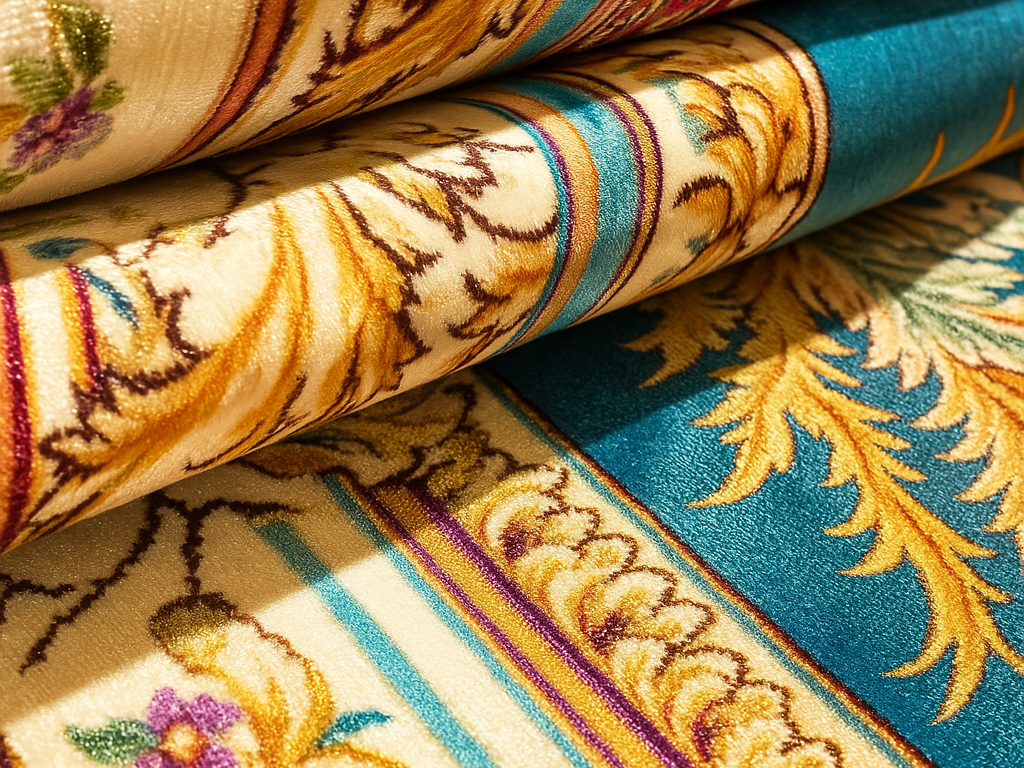Il est essentiel de garder vos tapis propres pour que votre maison soit fraîche et accueillante. Mais lorsqu'il s'agit de les laver, de nombreux propriétaires se posent des questions : Puis-je mettre mon tapis dans la machine à laver ? La réponse n'est pas évidente : elle dépend de la matière, de la taille et de la fabrication du tapis. Si certains tapis sont conçus pour être lavés en machine, d'autres nécessitent un entretien plus délicat.
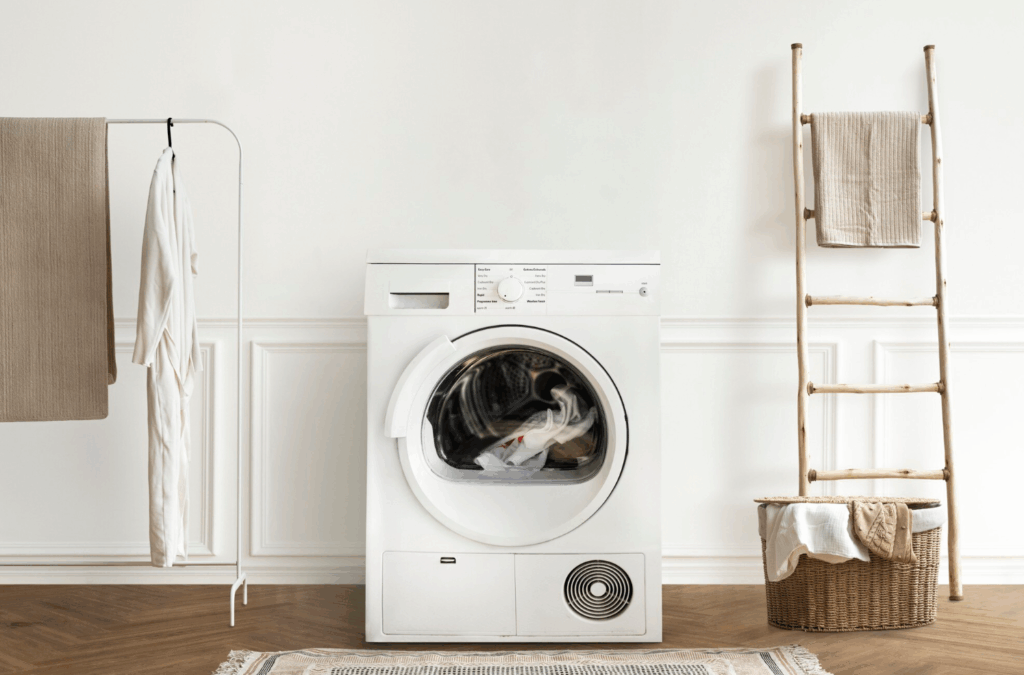
Dans ce guide complet, nous verrons quels sont les tapis qui peuvent être lavés en machine, comment les laver correctement et quelles sont les meilleures pratiques pour les sécher et préserver leur longévité. Qu'il s'agisse d'un petit tapis en coton ou d'un grand tapis synthétique, comprendre les choses à faire et à ne pas faire pour laver un tapis peut vous aider à garder vos sols impeccables sans les abîmer.
1. Le dilemme du lavage en machine pour les tapis - Ce n'est pas qu'une question de commodité
Mettre un tapis dans la machine à laver : c'est tentant, non ? L'attrait est indéniable : moins de tracas, une propreté rafraîchissante et, oui, la commodité. Mais ce simple geste cache des complexités liées aux matériaux, au support, à la taille et même à la machine à laver elle-même. Le lavage en machine de votre tapis est plus qu'un gain de temps, c'est un choix calculé. Si vous vous trompez, vous risquez de déformer les bords, d'abîmer le support, d'altérer les couleurs, voire d'abîmer votre laveuse. En réalité, tous les tapis ne sont pas créés égaux et toutes les machines à laver ne pardonnent pas. Décortiquons le puzzle pour que votre prochaine journée de lessive ne devienne pas un récit édifiant.
Lire aussi : Comment choisir le bon tapis pour votre salon ?
2. Points à prendre en compte avant de mettre votre tapis dans la machine à laver
Laver un tapis en machine peut être un moyen pratique d'en rafraîchir l'aspect, mais il est essentiel d'évaluer plusieurs facteurs avant de procéder. Un mauvais lavage peut entraîner des dommages, un rétrécissement, voire l'annulation de la garantie du tapis. Voici ce qu'il faut prendre en compte :
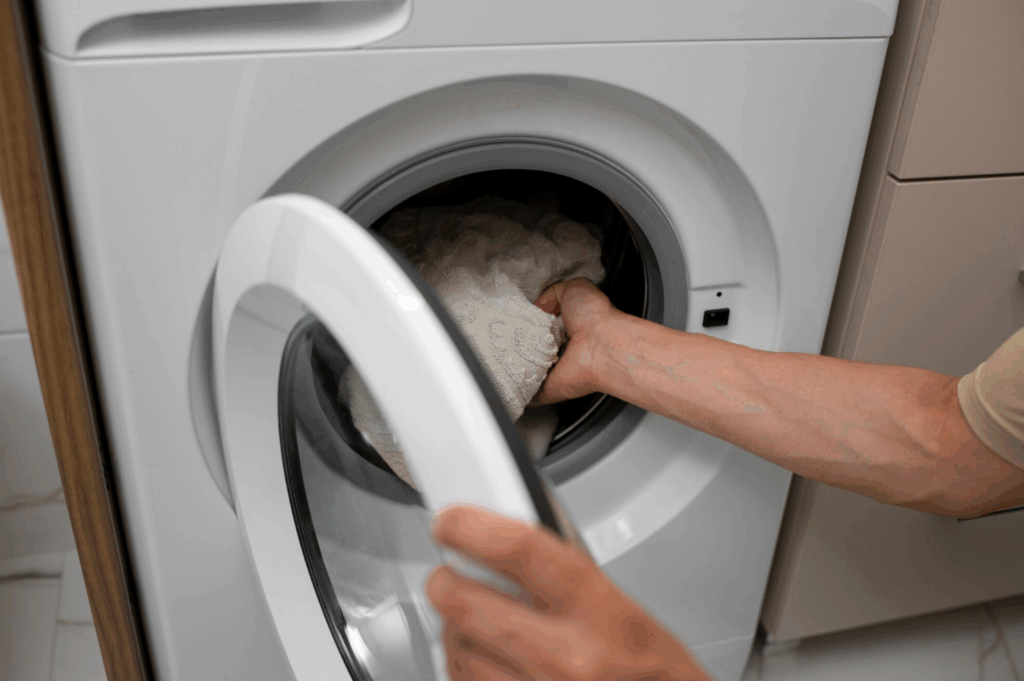
Vérifier l'étiquette d'entretien
Commencez toujours par examiner l'étiquette d'entretien du tapis. Les fabricants fournissent des instructions spécifiques sur les méthodes de nettoyage, notamment sur la possibilité de laver le tapis en machine. Ignorer ces directives peut entraîner des dommages involontaires.
Évaluer le matériau du tapis
La matière de votre tapis joue un rôle important dans la détermination de son aptitude au lavage en machine :
- Tapis en coton et synthétiques: En général, ces matériaux sont lavables en machine. Veillez toutefois à ce que leurs couleurs soient inaltérables et à ce qu'ils ne comportent pas d'ornements tels que des franges ou des glands qui pourraient s'effilocher.
- Laine, Soie, et fibres naturelles: Ces matériaux ne sont généralement pas adaptés au lavage en machine en raison de leur nature délicate. Le lavage peut les faire rétrécir, perdre leur texture ou les déformer.
- Tapis caoutchoutés: Bien que certains tapis à envers en caoutchouc soient étiquetés comme étant lavables en machine, il est essentiel de le vérifier. Le lavage peut parfois entraîner une détérioration du caoutchouc ou une perte d'adhérence.
Évaluer la taille et le poids du tapis
La taille et le poids du tapis sont des facteurs essentiels :
- Laveuse Capacité: Assurez-vous que votre machine à laver peut accueillir le tapis sans le surcharger. Une surcharge peut fatiguer la machine et empêcher le tapis de bien se nettoyer.
- Considérations relatives au séchage: Les tapis de grande taille ou lourds peuvent ne pas tenir dans votre sèche-linge. Un séchage à l'air libre peut s'avérer nécessaire, ce qui peut prendre du temps.
- Option laverie automatique: Si votre laveuse domestique ne convient pas, envisagez d'utiliser une machine de laverie commerciale conçue pour les grandes charges.
Inspecter les taches et les dommages
Avant le lavage :
- Taches: Traitez les taches éventuelles avec un détachant approprié avant le lavage. Cela permet de les traiter efficacement.
- Dommages: Vérifiez qu'il n'y a pas de dommages existants, tels que des bords effilochés ou des fils lâches. Le lavage peut aggraver ces problèmes.
Choisir le bon détergent et les bons paramètres
Il est essentiel de choisir le détergent et les réglages de la machine appropriés :
- Détergent: Utilisez un détergent doux adapté à la matière du tapis. Les produits chimiques agressifs peuvent provoquer une décoloration ou une détérioration.
- Réglages de la machine: Optez pour un cycle doux ou délicat avec de l'eau froide pour minimiser les risques de dommages.
- Éviter les additifs: N'utilisez pas d'eau de Javel ou d'assouplissants, car ils peuvent endommager les fibres et le dos du tapis.
Tenir compte du support du tapis
Le matériau du support influe sur la durabilité du tapis et sur la méthode de nettoyage :
- Support en jute ou en fibres naturelles: Ces articles ne sont pas adaptés au lavage en machine et peuvent nécessiter un nettoyage professionnel.
- Polyester ou support synthétique: Souvent plus durables et pouvant supporter un lavage en machine, mais vérifiez toujours l'étiquette d'entretien.
Séchage du tapis
Un séchage adéquat est essentiel pour préserver la forme et l'intégrité du tapis :
- Air Séchage: Poser le tapis à plat sur une surface propre, de préférence à l'extérieur, pour qu'il sèche à l'air libre. Évitez la lumière directe du soleil pour éviter que les couleurs ne s'altèrent.
- Utilisation du séchoir: Si l'étiquette d'entretien le permet, vous pouvez utiliser un sèche-linge à basse température. Toutefois, soyez prudent, car une chaleur élevée peut entraîner un rétrécissement ou une détérioration.
3. Matériaux de tapis qui sont Convivialité pour la machine Lavage
Lorsqu'il s'agit d'entretenir la propreté de vos tapis, il est essentiel de comprendre la composition du matériau. Certaines fibres se prêtent mieux au lavage en machine, ce qui garantit leur longévité et préserve leur attrait esthétique. Voici un aperçu détaillé des matières qui peuvent généralement être lavées en machine :

Fibres synthétiques : Les champions du lavage en machine
Les fibres synthétiques sont conçues pour être durables et faciles à entretenir, ce qui en fait des candidats idéaux pour le lavage en machine.
- Polypropylène (oléfine) : Connus pour leur résistance aux taches, à la décoloration et à l'humidité, les tapis en polypropylène sont un choix populaire pour les zones très fréquentées. Ils conservent leur couleur et leur texture même après plusieurs lavages.
- Nylon : Cette fibre présente une excellente résilience et peut supporter un trafic piétonnier intense. Tapis en nylon sont souvent traités pour résister aux taches, ce qui leur permet d'être lavés en machine.
- Polyester: Les tapis en polyester sont doux au toucher et se déclinent en une grande variété de motifs. Ils peuvent généralement être lavés en machine, à condition de respecter les instructions d'entretien.
- Polyéthylène téréphtalate (PET) : Souvent fabriqués à partir de matériaux recyclés, les tapis en PET sont écologiques et durables. Leur résistance à l'humidité et aux taches leur permet d'être lavés en machine.
Mélanges de fibres naturelles : Le meilleur des deux mondes
Alors que les fibres naturelles comme le jute et la laine ne sont généralement pas lavables en machine, les mélanges qui incorporent des fibres synthétiques offrent un équilibre entre l'esthétique naturelle et la commodité du lavage en machine.
- Mélanges de jute et de coton : Alliant le charme rustique du jute à la douceur du coton, ces tapis peuvent être lavés en machine si l'étiquette d'entretien le permet. Ils ont moins tendance à perdre leurs poils que les tapis en pur jute.
- Mélanges laine-synthétique : Ces mélanges visent à conserver le toucher luxueux de la laine tout en incorporant des fibres synthétiques qui améliorent la durabilité et la lavabilité. Vérifiez toujours les instructions d'entretien avant de laver en machine.
Modèles à poils ras et à tissage plat : Plus facile à nettoyer
Les tapis à poils ras ou à tissage plat se prêtent généralement mieux au lavage en machine en raison de leur légèreté et de leur compacité.
- Tapis à tissage plat : Ces tapis sont tissés sans poils, ce qui les rend moins susceptibles de retenir la saleté et plus faciles à nettoyer. Ils présentent souvent des motifs géométriques et sont réversibles.
- Tapis à poils ras : Grâce à leurs fibres plus courtes, les tapis à poils ras sèchent plus rapidement et ont moins tendance à retenir l'humidité, ce qui réduit le risque de moisissures.
4. La taille du tapis est importante : Est-il à sa place ?
Lorsqu'il s'agit de laver des tapis, la taille n'est pas qu'un simple chiffre - c'est un facteur essentiel qui peut déterminer si votre tapis survivra au cycle de lavage ou s'il sera abîmé. Il est essentiel de comprendre les dimensions de votre tapis et de les adapter à la capacité de votre machine à laver pour obtenir un nettoyage efficace et sûr.
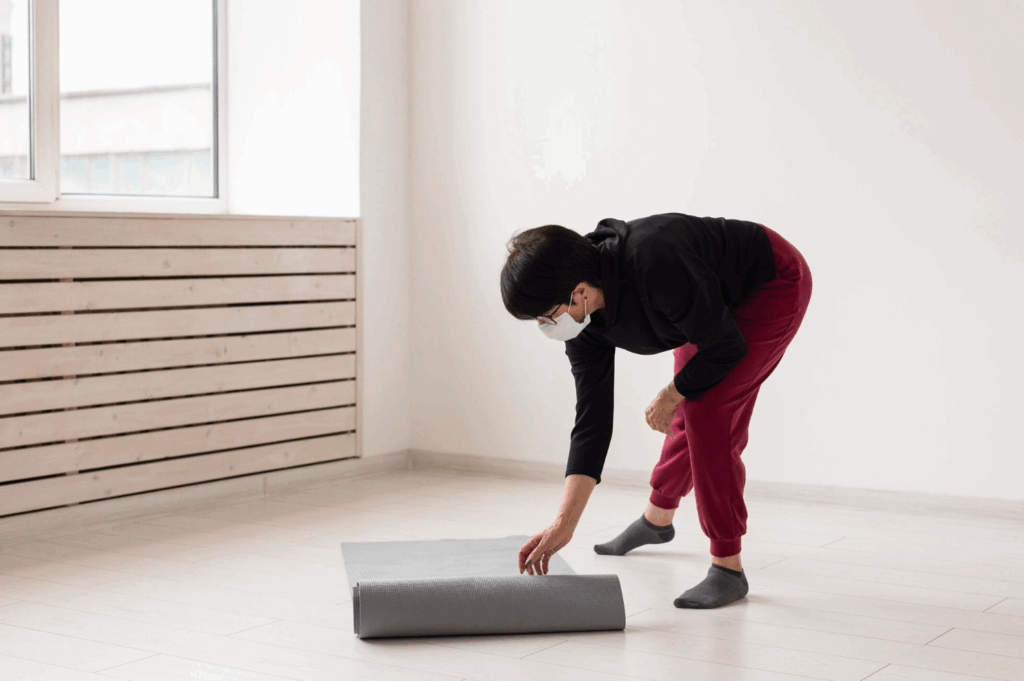
Adapter la taille du tapis à la capacité du lave-linge
Toutes les machines à laver ne sont pas créées de la même manière, et les tapis non plus. Avant de mettre votre tapis dans la machine à laver, assurez-vous que sa taille et son poids sont compatibles avec les spécifications de votre machine.
Capacité du lave-linge en fonction de la taille du tapis
- Laveuses de capacité standard (3,5 pi3) : Convient aux petits tapis jusqu'à 3′ x 5′.
- Laveuses de grande capacité (4.5 cu. ft.) : Peut traiter des tapis de taille moyenne, généralement jusqu'à 5′ x 7′.
- Laveuses à très grande capacité (5.2+ cu. ft.) : Conçu pour les tapis plus grands, tels que 8′ x 10′ et plus.
Par exemple, un tapis de 9′ x 12′ nécessite une laveuse d'une capacité minimale de 5,5 pi3 sans agitateur. Si votre laveuse ne répond pas à ces spécifications, envisagez d'utiliser une machine de qualité commerciale dans une laverie automatique.
Poids sec vs. poids humide
Les tapis prennent beaucoup de poids lorsqu'ils sont mouillés, ce qui peut mettre à rude épreuve votre machine à laver. Un tapis en coton sec de 3 livres peut peser jusqu'à 7-8 livres lorsqu'il est trempé. Assurez-vous que votre lave-linge peut supporter ce poids accru afin d'éviter tout dommage.
Type de laveuse et compatibilité avec les tapis
Le type de machine à laver que vous possédez joue également un rôle dans la détermination des tapis qui peuvent être lavés en toute sécurité.
- Laveuses à chargement frontal : Doux pour les tapis et souvent préféré pour le lavage.
- Laveuses à chargement par le haut avec agitateurs : Peut être agressif pour les tapis ; veillez à ce que le tapis soit bien équilibré pour éviter de l'endommager.
- Laveuses à chargement par le haut sans agitateur : Ils offrent plus d'espace et sont généralement plus doux pour les tapis.
Vérifiez toujours l'étiquette d'entretien de votre tapis et le manuel de votre laveuse pour vous assurer de la compatibilité.
Lire aussi : Comment choisir la bonne taille de tapis : Un guide pièce par pièce
5. Étape par étape : Comment laver votre tapis ?
Laver son tapis à la maison peut être une tâche simple si l'on s'y prend méthodiquement. En suivant un processus structuré, vous pouvez nettoyer efficacement votre tapis tout en préservant son intégrité. Voici un guide détaillé qui vous aidera à franchir chaque étape :

Étape 1 : Préparation du tapis
Passez l'aspirateur à fond : Commencez par passer l'aspirateur sur les deux faces du tapis pour enlever la saleté, la poussière et les débris. Cette étape est cruciale pour éviter que la saleté ne s'incruste plus profondément dans les fibres pendant le lavage. Pour un résultat optimal, utilisez un aspirateur équipé d'une barre de battage ou d'une brosse rotative.
Vérifier l'absence de taches : Inspectez le tapis pour vérifier qu'il n'y a pas de taches ou de points visibles. Traitez ces zones avec un détachant approprié avant de laver le tapis. Appliquez le détachant conformément aux instructions du fabricant et laissez-le agir pendant la durée recommandée.
Lire l'étiquette d'entretien : Vérifiez toujours l'étiquette d'entretien du fabricant pour connaître les instructions de lavage spécifiques. Certains tapis peuvent avoir des exigences ou des restrictions particulières qu'il est important de respecter.
Étape 2 : Régler votre machine à laver
Sélectionnez le cycle approprié : Choisissez un cycle doux ou délicat dans votre machine à laver. Ce réglage utilise une agitation plus lente et des temps d'essorage plus courts, réduisant ainsi le risque d'endommager le tapis.
Utiliser de l'eau froide : Réglez la température de l'eau sur froid. L'eau chaude peut entraîner le rétrécissement de certaines fibres ou la décoloration des couleurs. L'eau froide permet de conserver la taille et l'aspect du tapis.
Ajouter le détergent : Utilisez un détergent doux, non javellisé, adapté à la matière du tapis. Évitez d'utiliser des assouplissants, car ils peuvent laisser des résidus qui attirent la saleté.
Équilibrer la charge : Si le tapis est petit, pensez à ajouter quelques serviettes au lavage pour équilibrer la charge. Cela permet au lave-linge de fonctionner efficacement et empêche le tapis de se déséquilibrer pendant le cycle d'essorage.
Étape 3 : Laver le tapis
Charger le tapis : Placez le tapis dans la machine à laver, en veillant à ce qu'il soit réparti uniformément. Évitez de surcharger la machine, car vous risqueriez de ne pas nettoyer correctement le tapis et de l'endommager.
Démarrer le cycle de lavage : Commencez le cycle de lavage et surveillez la machine pour vous assurer qu'elle fonctionne correctement. Si la machine est déséquilibrée, interrompez le cycle et redistribuez le tapis avant de reprendre.
Étape 4 : Sécher le tapis
Sécher à l'air : Une fois le cycle de lavage terminé, retirez rapidement le tapis. Posez-le à plat sur une surface propre et sèche dans un endroit bien ventilé pour qu'il sèche à l'air. Évitez de le suspendre, car il risque de s'étirer ou de perdre sa forme.
Éviter la lumière directe du soleil : Ne placez pas le tapis en plein soleil, car les couleurs risquent de pâlir et les fibres de s'affaiblir. Optez pour un endroit ombragé où l'air circule bien.
Vérifier la sécheresse : Veillez à ce que le tapis soit complètement sec avant de le replacer à son emplacement d'origine. Toute humidité résiduelle peut entraîner la formation de moisissures.
Soins après lavage
Restaurer la pile : Une fois le tapis sec, ébouriffez délicatement les fibres à la main ou à l'aide d'une brosse douce pour lui redonner son aspect.
Repositionner le tapis : Replacez le tapis à son emplacement d'origine, en veillant à ce qu'il soit bien à plat et qu'il ne se déforme pas.
Entretien régulier : Pour garder le tapis propre, passez l'aspirateur régulièrement et éliminez rapidement les taches ou les éclaboussures. Envisagez de laver le tapis périodiquement, en fonction de son utilisation et des recommandations du fabricant.
6. Les erreurs à éviter lors du lavage de votre tapis
Laver son tapis à la maison peut être un moyen pratique et économique de le maintenir propre. Toutefois, certaines erreurs peuvent entraîner des dommages, une réduction de la durée de vie ou un nettoyage inefficace. En étant conscient de ces erreurs courantes, vous pouvez vous assurer que votre tapis reste en parfait état.

Utilisation de produits chimiques agressifs
L'utilisation de nettoyants chimiques puissants peut être préjudiciable aux fibres et aux couleurs de votre tapis. Les nettoyants à pH élevé ou acides, tels que les produits à base d'eau de Javel, peuvent décaper les huiles naturelles, provoquer des décolorations ou affaiblir les fibres. Il est conseillé d'utiliser des nettoyants à pH neutre ou des détergents doux spécialement conçus pour les tapis. Testez toujours un produit de nettoyage sur une petite surface peu visible avant de l'appliquer à l'ensemble du tapis.
Mouiller le tapis à l'excès
Un excès d'eau pendant le nettoyage peut entraîner des temps de séchage longs, la formation de moisissures et l'endommagement du dos du tapis. Cette erreur est particulièrement dommageable pour les tapis en fibres naturelles ou à motifs complexes. Utilisez un minimum d'eau et épongez les taches plutôt que de les imbiber. Évitez d'immerger complètement votre tapis, sauf si cela est explicitement recommandé pour son matériau.
Oublier l'entretien régulier
Négliger l'entretien de routine est l'une des plus grandes erreurs commises par les propriétaires. La poussière, la saleté et les débris s'accumulent dans les fibres des tapis, ce qui entraîne leur usure et leur décoloration. Il est essentiel de passer régulièrement l'aspirateur pour empêcher la saleté de s'incruster profondément dans le tapis. Passez l'aspirateur au moins une fois par semaine, en utilisant un réglage à faible aspiration pour les matériaux délicats. Changez votre tapis de place tous les deux mois pour qu'il s'use uniformément.
Frotter les taches de manière agressive
Frotter agressivement les taches peut enfoncer la saleté plus profondément dans les fibres et provoquer un effilochage ou une déformation de la texture du tapis. Au lieu de frotter, épongez la zone tachée avec un chiffon propre et absorbant pour soulever la tache. Si nécessaire, utilisez une brosse à poils doux ou une éponge avec une solution de détergent doux pour travailler doucement sur la tache. Travaillez toujours de l'extérieur de la tache vers l'intérieur pour éviter qu'elle ne s'étende.
Ignorer l'étiquette d'entretien
Chaque tapis est accompagné d'instructions d'entretien spécifiques fournies par le fabricant. Ignorer ces instructions peut entraîner des dommages irréversibles. Vérifiez toujours l'étiquette d'entretien pour connaître les instructions de lavage, notamment la température de l'eau recommandée, le type de détergent et les méthodes de séchage. Si l'étiquette déconseille le lavage en machine, il est préférable de suivre cette recommandation pour préserver l'intégrité du tapis.
Surcharge du lave-linge
Placer un tapis lourd ou de grande taille dans la machine à laver peut fatiguer l'appareil et ne pas permettre un nettoyage en profondeur. Si le tapis n'entre pas confortablement dans la machine, envisagez d'utiliser la laveuse industrielle plus grande d'une laverie automatique ou d'opter pour des méthodes de nettoyage à la main. La surcharge peut également déséquilibrer le lave-linge, ce qui risque de l'endommager.
Séchage incorrect
Un mauvais séchage peut entraîner des odeurs, des moisissures et des champignons. Suspendre les tapis à la lumière directe du soleil peut en altérer les couleurs, tandis que les faire sécher à plat sur une surface peut emprisonner l'humidité. Faites sécher les tapis à l'air libre dans un endroit bien ventilé et à l'ombre. Utilisez des ventilateurs pour accélérer le processus de séchage. Évitez de poser des tapis mouillés sur du bois dur ou de la moquette pour ne pas les abîmer.
Utiliser le mauvais cycle de lavage
Le choix d'un cycle de lavage inapproprié peut endommager votre tapis. Choisissez toujours un cycle doux ou délicat pour minimiser l'agitation. Évitez d'utiliser de l'eau chaude, car elle peut entraîner un rétrécissement ou une décoloration. L'eau froide est généralement plus sûre et plus efficace pour la plupart des tapis. En outre, évitez d'utiliser de l'eau de Javel ou des détergents agressifs, sauf si l'étiquette d'entretien l'autorise expressément.
La solidité des couleurs n'est pas testée
Avant de laver le tapis, surtout s'il est de couleur vive ou à motifs, vérifiez la solidité des couleurs. Humidifiez une petite zone peu visible avec de l'eau et épongez-la avec un chiffon blanc. Si la couleur se transfère sur le chiffon, le tapis risque de déteindre au lavage. Dans ce cas, il est conseillé de faire appel à un nettoyeur professionnel ou d'opter pour des méthodes de nettoyage à sec.
Négliger le nettoyage professionnel lorsqu'il est nécessaire
Certains tapis, en particulier ceux fabriqués à partir de fibres naturelles comme la laine ou la soie, peuvent nécessiter un nettoyage professionnel pour conserver leur aspect et leur longévité. Tenter de nettoyer ces tapis à la maison peut les endommager. En cas de doute, faites appel à des services de nettoyage professionnels pour assurer un entretien adéquat.
7. Conseils d'entretien après le lavage des tapis
Vous venez de laver votre tapis - félicitations ! Mais le nettoyage ne s'arrête pas lorsque le tapis est sec. Un entretien intelligent et régulier après le lavage garantit la fraîcheur, la longévité et la sensation de “ fraîchement lavé ” pendant beaucoup plus longtemps.
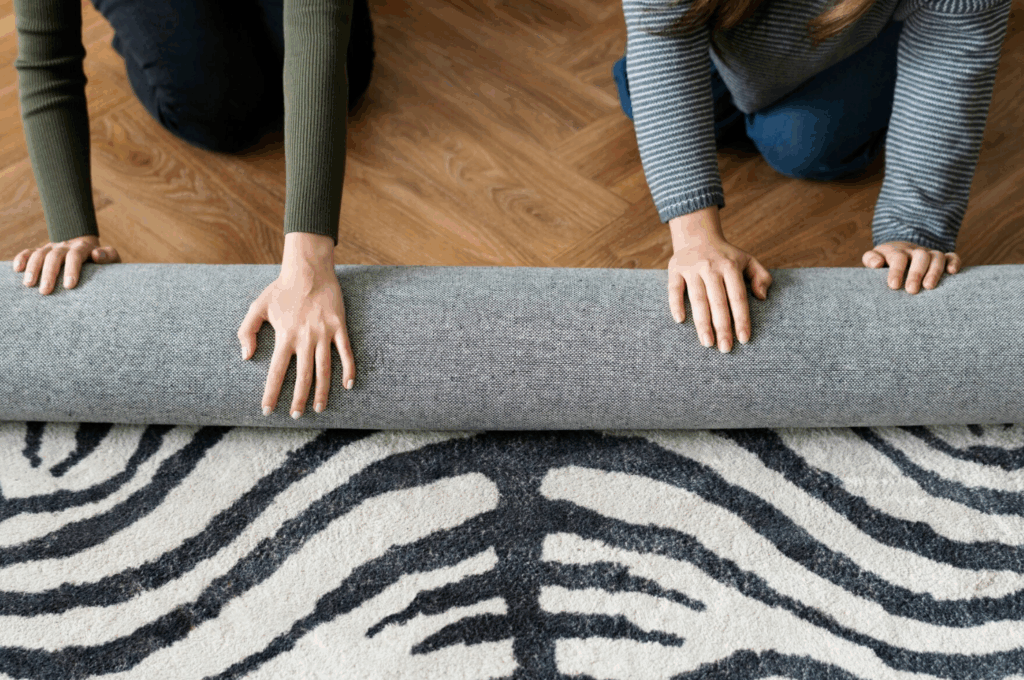
Passer l'aspirateur régulièrement et de manière ciblée
Passer l'aspirateur régulièrement reste la pierre angulaire de l'entretien des tapis :
- Viser à passer l'aspirateur au moins une fois par semaine-Il est recommandé de passer l'aspirateur plus souvent si vous avez des animaux de compagnie, des enfants ou des zones très fréquentées. Un passage régulier de l'aspirateur permet d'éliminer les particules incrustées dans les fibres qui contribuent à l'usure.
- Pour les tapis délicats ou à poils longs, utiliser des aspirateurs à succion ou désactiver les barres de brosses rotatives pour éviter d'accrocher les fibres ou d'endommager les franges.
Tournez votre tapis pour uniformiser l'usure et la couleur
La rotation permet au tapis de s'user plus uniformément :
- Retourner ou faire pivoter votre tapis tous les 3 à 6 mois - ou plus souvent dans les zones très fréquentées - pour éviter qu'il ne se décolore ou ne s'aplatisse.
Utiliser des tapis pour la protection et la stabilité
Les tapis ne se contentent pas d'empêcher de glisser :
- Un bon le tapis rembourre votre tapis, Le tapis de sol est plus résistant, il amortit l'impact du passage des piétons et aide à maintenir la structure. Il améliore également la circulation de l'air sous le tapis, ce qui réduit considérablement les dommages liés à l'humidité au fil du temps.
Nettoyage immédiat des taches (doux et intelligent)
Une réaction rapide permet d'éviter les taches permanentes :
- Éponger rapidement les liquides renversés-Ne jamais frotter. Utilisez des chiffons absorbants et travaillez des bords de la tache vers l'intérieur.
- Poursuivre avec un légère brume de vinaigre et d'eau pour raviver le gonflant des fibres ; détachez ensuite délicatement les poils avec une cuillère pour leur redonner fraîcheur et texture.
Aplanir facilement les rides et les coins
Les tapis qui sortent du lave-linge peuvent se froisser :
- Si les coins ou les plis se recroquevillent, placez un glaçon sur la zone concernée, laissez-le fondre toute la nuit, puis séchez-le par tamponnement - cela permet d'aplatir naturellement les plis tenaces.
Gérer l'humidité et éviter les environnements humides
Prévenir les moisissures et les odeurs de renfermé :
- Gardez les tapis dans des endroits secs et bien ventilés.
- Utiliser un déshumidificateur dans les zones humides pour protéger les fibres naturelles et éviter l'accumulation d'odeurs.
De temps en temps, faites appel à des professionnels
Bien que l'entretien à domicile permette de conserver la fraîcheur des tapis, le nettoyage professionnel a sa place :
- Taches profondes, odeurs ou textiles délicats (comme les antiquités ou les tapis faits main) nécessitent souvent des procédés doux et spécialisés que les méthodes de bricolage ne peuvent pas reproduire.
- Une bonne règle empirique est la suivante nettoyage professionnel une fois par an, ou plus fréquemment dans les foyers à forte fréquentation.
Les mauvaises habitudes qui usent les tapis
Évitez les habitudes de vie qui dégradent rapidement la qualité du tapis :
- Ramassez le pas de chaussures à l'intérieur En règle générale, passez l'aspirateur sous les tapis et évitez de renverser de l'eau végétale, les taches silencieuses comme les chaussures d'intérieur et les nettoyages en profondeur manquants accélèrent l'accumulation de la saleté et l'usure.
Limiter les lavages - laisser les tapis respirer entre deux lavages
Un lavage excessif peut faire plus de mal que de bien :
- La plupart des tapis de maison n'ont besoin que de lavage une ou deux fois par an. Les lavages fréquents peuvent affaiblir les fibres et ternir la couleur, même si le tapis semble propre.
8. Conclusion
Le lavage de votre tapis dans le lave-linge est-il sans danger ? Oui, parfois. Lorsque les matériaux sont compatibles, que les tailles sont adaptées et que vous suivez des étapes précises, le lavage en machine peut s'avérer efficace. Mais ce n'est pas universel. Les tapis synthétiques ou en coton, en particulier ceux qui sont spécialement conçus, s'en sortent bien. Les tapis naturels, anciens, lourds ou à dos collé ? Pas vraiment. En équilibrant choix judicieux, préparation réfléchie et entretien, vous garderez vos tapis frais et votre laveuse intacte.
9. FAQ
- Puis-je laver en machine un tapis en laine ou en soie ?
Les fibres non naturelles comme la laine et la soie sont délicates et peuvent rétrécir ou se déformer. Mieux vaut les laver à la main ou faire appel à un professionnel.
2. Que se passe-t-il si mon tapis a un envers en caoutchouc ?
Utilisez uniquement de l'eau froide et des cycles doux ; évitez la chaleur et les produits de blanchiment, car l'endos pourrait se dégrader.
3. Un tapis de 5×7 pieds peut-il être lavé dans une laveuse domestique ?
Seulement si votre lave-linge est de grande capacité et conçu sans agitateur. Dans le cas contraire, envisagez de vous rendre dans une laverie automatique ou d'utiliser une autre méthode de nettoyage.
4 .Puis-je mettre des tapis dans le sèche-linge ?
Uniquement si l'étiquette d'entretien le permet, et même dans ce cas, sur des réglages sans chaleur ou à l'air libre. Le séchage à l'air libre à plat ou suspendu est plus sûr.
5. Comment éliminer les odeurs d'animaux domestiques lors du lavage d'un tapis ?
En plus du détergent, ajoutez environ ½ tasse de vinaigre blanc pour neutraliser les odeurs, ce qui est particulièrement utile pour les tapis en peluche ou lavables.

